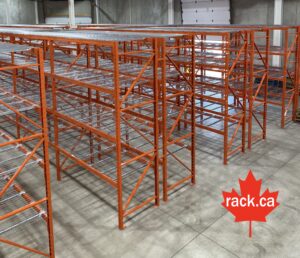Warehouses play a big role in the success of businesses that deal with physical goods. Their primary function is to provide ample storage space for inventory, equipment, and other items. Hence, the proper design of the warehouse layout is very important in maximizing productivity, optimizing storage space, and ensuring smooth operations in the warehouse.
Whether you’re starting fresh or revamping your warehouse layout, your warehouse racking design must be one of your priorities because it determines how your products will be stored, gives you efficient access to those products, and provides seamless navigation.
This article contains 10 expert tips every warehouse owner needs to know to design an efficient warehouse racking layout.

Tips for Designing an Efficient Warehouse Racking Layout
Analyze Warehouse Space and Workflow
Assessing your available space and understanding the workflow within your warehouse is the first step in designing your warehouse layout. A well-designed layout should reduce travel time and enable workers, goods, and equipment to navigate the warehouse and operate without hindrance. This will allow your warehouse to function smoothly.
Categorize and Organize Products
What types of products do you store? What is their shelf life? If you store perishable items such as food or medicine, a first in first out racking system (FIFO) is the way to go. If you store products with no expiry dates, then the last in first out (LIFO) inventory management system is ideal for your warehouse. With LIFO, the last items stored will be the first to be sent out.
Once you understand your inventory, you can group similar products and use the appropriate racking system for each. For instance, cantilever racks are ideal for storing long and heavyweight goods such as pipes, and double-deep pallet racking is suitable for storing large quantities of the same product type.
Optimize Aisle Widths and Rack Spacing
The aisle is the space between the racks. It is the passageway for the workers and equipment to move through. You want to ensure that the forklift can turn well while loading and unloading the goods in the aisle, so you must ensure that aisle width is adequate for smooth navigation but also to avoid any unnecessary wasted space.
Utilize Vertical Space Efficiently
You can make the most of your warehouse’s vertical space by installing a mezzanine above a floor-level process, narrowing your aisles, and adopting narrow aisle lift trucks.
Consider Accessibility and Inventory Management
A good layout design should allow for easy access to inventory items. Assessing your warehousing requirements will help you select the appropriate racking type that ensures seamless accessibility and efficient management of your inventory.
Incorporate Safety Measures
Your warehouse must comply with safety regulations. It must be designed in a way that prevents the risk of accidents or damage to your inventory. You should implement proper safety protocols such as clear pathways, guardrails, and adequate lighting for visibility.
Implement Clear Signage and Labelling Systems
Clear signage and labeling in the warehouse help employees navigate faster and locate items easily. Properly labelled racks, aisles, or shelves will enhance accuracy and speed during inventory management.
Design Efficient Loading and Unloading Areas
Allocating dedicated spaces for loading and unloading activities is also important for smooth operation in the warehouse. If you have enough space, you should build your loading and unloading areas in the warehouse. This will allow easy access to the docking point and allows trucks to connect easily and unload products directly inside the building. This streamlines the process and eliminates the need for manual handling, saving time and effort.
If you have limited space, however, a forklift transfers products from trucks to the warehouse, where they are placed in the reception area. This will facilitate efficient movement of goods and enable organized reception and storage within the warehouse.
Consider Future Scalability and Flexibility
If you plan to increase your warehouse storage space in the future, you should design a layout that allows for scalability. Consider adjustable racking systems and modular designs that can be easily reconfigured to accommodate changing inventory requirements.
Perform Ongoing Evaluation and Continuous Improvement
Lastly, regularly evaluating your warehouse’s efficiency to see areas that need improvement is very important. Welcome feedback from the staff and implement necessary adjustments to enhance productivity.
Talk to the Team at Canadian Rack Technologies Inc.
Designing an efficient warehouse racking layout can help optimize storage space, increase inventory accessibility, and boost overall efficiency. With these 10 expert tips, you’ll be well-equipped to create a warehouse racking layout that drives success in your business.
Canadian Rack Technologies Inc. is one of the leading distributors of high-quality and fully customizable storage racks in Toronto, Ontario. We’ve worked with a number of warehouses across the province over the years to help maximize their operations and improve space efficiency. Contact us today to learn more about our products.

